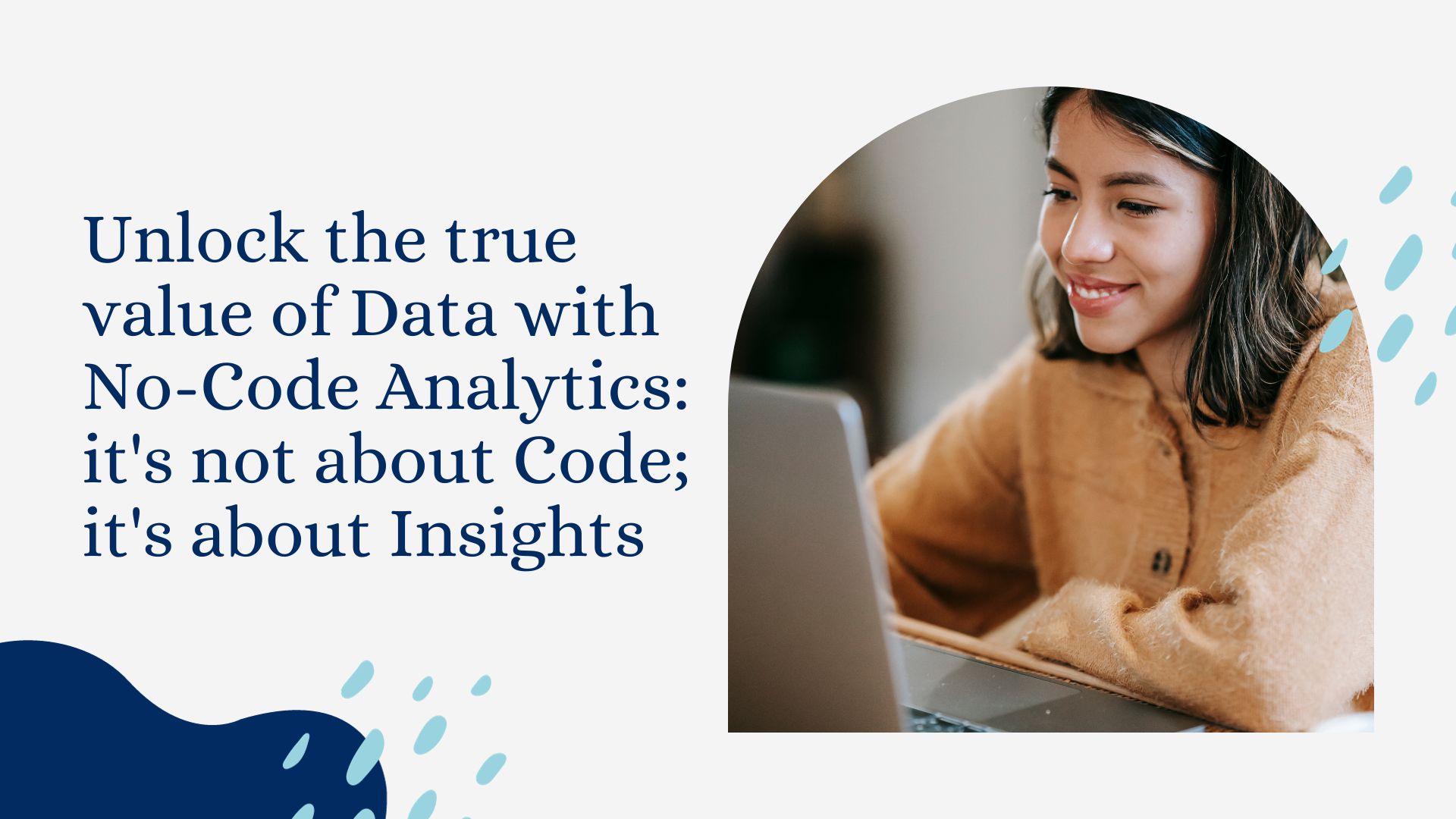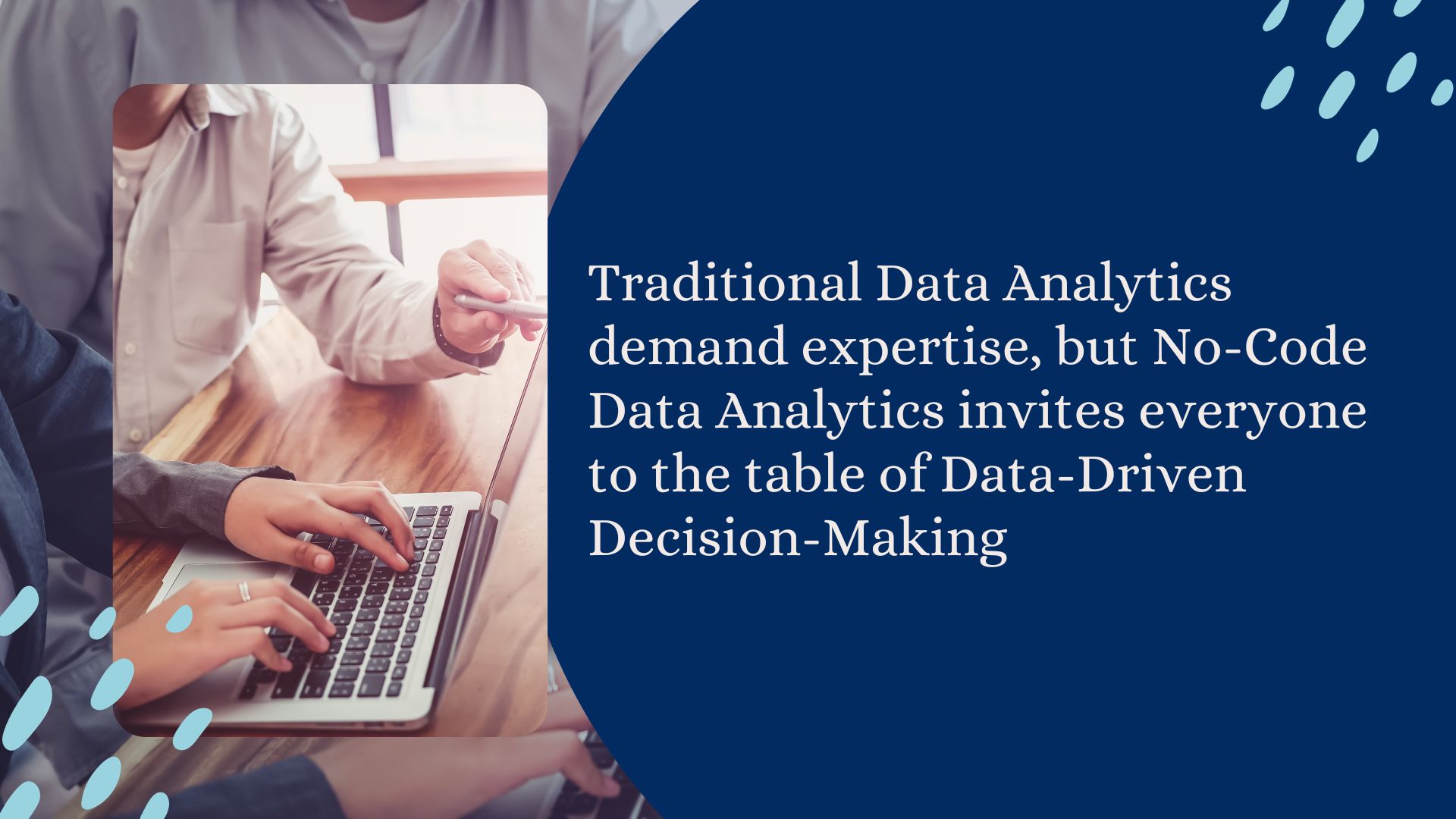Introduction

Companies are constantly looking for ways to harness the power of Data to make informed decisions, gain competitive advantage, and drive innovation. Traditional Data Analytics play an important role in this journey, but often come with challenges that require specialized skills and resources.
But No-Code Data Analytics, a revolutionary approach that promises to Democratize Data and empower individuals across industries. In this blog, we explore why No-Code Data Analytics could be the future of Data-Driven Decision making.
The Power of Data: Unleashing Insights, Trends, and Strategies
Data is often hailed as the new oil, and for good reason. It’s a valuable resource that can help organizations identify hidden insights, identify trends, and strategize optimally.
From e-commerce platforms analyzing consumer behavior to healthcare professionals enhancing patient care, the potential applications of Data Analytics are vast and varied.
Traditional Data Analytics, often based on SQL queries, Python, R, or other programming languages, have enabled organizations to leverage this capability. However, there are some inherent challenges:
Skill Gap
Highly skilled Data Scientists and Analysts are in high demand but not in short supply. Training and hiring them can be expensive and time-consuming.
Challenges
Writing rules to extract, transform, and analyze them can be complex and error-prone, causing delays and frustration.
Reliance
Organizations tend to rely too heavily on a handful of Data Experts, limiting the scope for Data-Driven Decision-making.
Scalability
Traditional methods can struggle to scale by generating high volumes and complexity of Data in today’s digital landscape.
Entering the Future: No-Code Data Analytics
No-Code Data Analytics aims to address these challenges by providing tools and platforms that enable non-technical users to work with Data effectively. It does this by:
Democratizing Data access
“No-Code” platforms enable Data to reach a wider audience within an organization, including business analysts, marketers and business units.
Reduce complexity
Users can perform tasks such as Data Cleansing, Transformation, and Visualization without writing a Single line of Code.
Fostering collaboration
By enabling cross-functional teams to work with Data, “No-Code” tools encourage collaboration and diversity of perspectives in Data Analysis.
Faster search
With intuitive interfaces, “No-Code” solutions reduce search time, enabling organizations to make faster decisions.
Unlocking the Benefits: Key Advantages of No-Code Data Analytics

Now that we understand the essence of No-Code Data Analytics, let’s take a deeper look at why it’s considered the Future of Data-Driven decision making.
Accessibility and Inclusivity
“No-Code” platforms lower the barrier to entry for Data Analysis. It does not require users to have a deep understanding of programming languages or complex methods of Data Manipulation.
This access Democratizes Data within an organization, allowing more individuals to participate in Data-Based activities. Business professionals can now directly Access and Analyze Data, enabling a culture of Data-Driven Decision-Making across all departments.
Rapid Prototyping and Iteration
In a rapidly changing business environment, the ability to prototype and iterate quickly is paramount. “No-Code” tools allow users to create and test Data Models and dashboards without extensive Coding.
This flexibility is crucial to adapt to changing market conditions and customer preferences. It encourages experimentation, innovation, and the discovery of new opportunities through Data.
Collaboration and Knowledge Sharing
No-Code Data Analytics encourage collaboration between technical and non-technical teams. Data Analysts can set up Data Pipelines and Models, while business professionals can use these resources to make decisions.
This collaborative approach shares knowledge, breaks down silos, and ensures that Data Insights are integrated into all aspects of an organization’s use cases.
Scalability and Efficiency
As organizations collect and generate increasingly large volumes of Data, scalability becomes a critical concern. No-Code Data Analytics platforms are designed to handle massive datasets and complex analytics tasks without requiring users to optimize code or infrastructure.
This scalability ensures that Data Analytics efforts can keep pace with the growing demands of modern businesses.
Focus on Value, Not Technicalities
Traditional Data Analytics typically require significant Data Preprocessing and Cleaning time. With “No-Code” tools that automate these tasks, Data Professionals can focus more on extracting valuable insights and solving complex business problems.
This shift in focus from technology to value-added activities increases the overall impact of Data Analytics.
Cost-Efficiency
Training and hiring Data Scientists and engineers can be expensive. No-Code Data Analytics reduces the need for large teams of core personnel, making it a cost-effective solution for organizations of all sizes while also reducing ongoing maintenance costs associated with Data Pipelines and workflows of maintaining complexity.
Bringing Data to Life: Real-World Applications of No-Code Data Analytics
No-Code Data Analytics is already making waves in various industries. Here are a few practical examples.
Marketing and customer research
Marketing teams can use “No-Code” tools to analyze consumer behavior, track campaign performance, and segment audiences for personalized marketing programs. This allows them to adopt Data-Driven Marketing Strategies without relying solely on Data Analysts.
Health and Life Sciences
Researchers and healthcare professionals can use “No-Code” platforms to analyze patient Data, conduct clinical trials, and identify potential treatments or interventions This accelerates medical research and improves patient care improve.
Financial Services
In finance, “No-Code” analytics can be used for fraud detection, risk assessment and portfolio optimization. Non-technical professionals can gain valuable insights into market trends and consumer behavior.
E-Commerce
E-commerce businesses can use No-Code Data Analytics to optimize product recommendations, manage inventory, and analyze customer reviews. This improves customer experience and increases sales.
Wrapping it Up
No-Code Data Analytics represent a paradigm shift in how organizations use Data to make decisions. By Democratizing Data, reducing complexity and fostering collaboration, it enables more individuals to harness the power of Data.
As we move forward into an increasingly Data-Centric world, No-Code Data Analytics is well positioned to drive innovation, improve productivity, and open up new opportunities across industries This transformational approach is conducting Data Analysis this adoption is not a coincidence It is a strategic imperative for businesses that want to succeed in the future.




